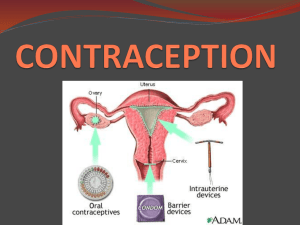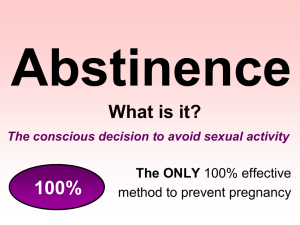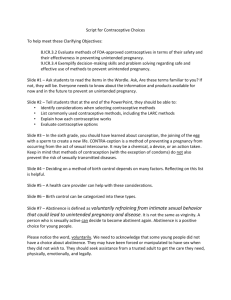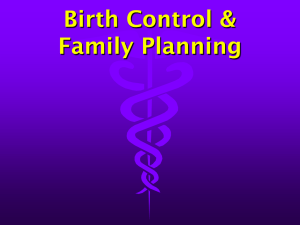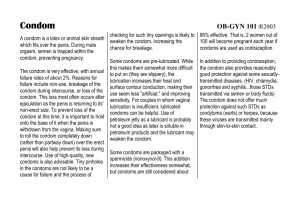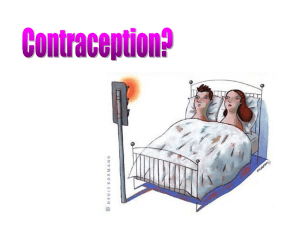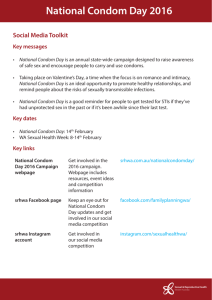CONTRACEPTION
advertisement
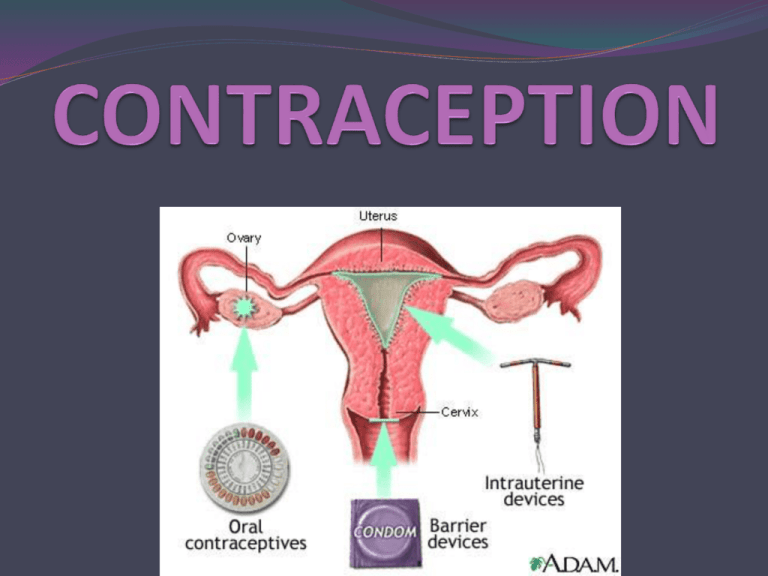
Types of Contraception 1. Barrier contraceptives 2. Hormonal contraceptives 3. Sterilization Note: No single method of birth control is the “best” one. Each has its own advantages and disadvantages. Abstinence is the only 100% effective way to prevent pregnancy and STD’s Barrier Contraceptives Methods that physically or chemically block sperm from reaching an egg AND provide a BARRIER between direct skin to skin contact Act as a physical block between you and your sexual partner Great for STD protection! Types: MALE CONDOMS Male Condom, Cont. Male Condom: Male condoms are 82 to 98 percent effective at preventing pregnancy Condoms can only be used once Do not use oil-based lubricants such as massage oils, baby oil, lotions, or petroleum jelly.They will weaken the condom, causing it to tear or break. Water-based are the best – can prevent breaking of condom. Good choices: Latex condoms and polyurethane Bad choices: Never choose “natural” or “lambskin” https://www.youtube.com/watch?v=VZmwEgK2AEA Friends clip Female Condom Female Condom, cont… Female Condom: Female condoms are 79 to 95 percent effective Worn by the woman, this method keeps sperm from getting into her body It can be inserted up to eight hours before sexual intercourse (though not necessary) Dental Dam Small, thin, square pieces of latex Used to keep partners' body fluids out of each other's bodies Can help to prevent skin-to-skin contact Placed on the vulva or the anus when the mouth, lips, or tongue are used to sexually arouse a partner. Can also cut a condom open on one side Hormonal Methods Methods that prevent the release of an egg (ovulation) Prevents a fertilized egg from implanting in the uterus (prevents pregnancy). NO hormonal methods reduce chances of STD’s! Oral Contraceptives Also called “the pill,” Some contain estrogen, progestin, or mix of other hormones depending on pill The pill is 91 to 99 percent effective at preventing pregnancy. Prescribed by doctor A pill is taken at the same time each day (once a day for three weeks, no pill fourth week -will get menstrual period) Birth Control Patch This skin patch is worn on the lower abdomen, buttocks, or upper body The patch is 91 to 99 percent effective at preventing pregnancy It releases hormones progestin and estrogen into the bloodstream You put on a new patch once a week for three weeks. During the fourth week, you do not wear a patch, so you can have a menstrual period Vaginal Ring The birth control ring releases the hormones progestin and estrogen It is 91 to 99 percent effective at preventing pregnancy Ring goes inside vagina up around your cervix You wear the ring for three weeks, take it out for the week you have your period, and then put in a new ring This method does not protect you from HIV or other STDs. Birth Control Shot Every 3 months (or 12 weeks), women get shots of the hormone progestin in the buttocks or arm from their doctor. It is 94 to 99 percent effective at preventing pregnancy. It does not protect you from HIV or other STDs Emergency Contraception Also known as the “morning after pill” The pills are 75 to 89 percent effective at preventing pregnancy Can be taken up to 3-5days AFTER unprotected sex (depending on brand) No prescription needed over age of 15 Effectiveness decreases after 24 hours Emergency contraception should only be used after no birth control was used during sex, or if the birth control method failed, such as if a condom broke Intrauterine Device It is placed inside the uterus by a doctor. 99% effective at preventing pregnancy Copper IUD: Can stay for up to 10 years Interferes with sperm, fertilization, and prevents implantation Hormonal IUD: Can stay for up to 5 years It releases a small amount of hormone each day to keep you from getting pregnant. Sterilization Vasectomy: This operation is done to keep a man’s sperm from going to his penis, so his ejaculate never has any sperm in it that can fertilize an egg. Operation is more simple than tying a woman’s tubes Sterilization Tubal ligation or “tying tubes.” A woman can have her fallopian tubes tied (or closed) to stop eggs from being fertilized Over time, the ends of your fallopian tubes could fuse back together, and it may be possible to get pregnant Review If male puts on a condom the wrong way, he should take it off, and put it on the right way? Yes or no? NO!!! There could still be pre-ejaculatory semen (WITH SPERM) on the outside, now heading to the female….std’s and pregnancy are possible. GET A NEW ONE!!!! Review Put the following in order for the best options in reducing your chances of STD’s: A) Male Condom B) Birth Control Pill C) Abstinence Review Answer: C) Abstinence A) Male Condom ONLY, because B) Birth Control Pill does NOT protect against STD’s, only pregnancy! Review True or False: A male condom can be used again FALSE: ONLY ONCE- them remove QUICKLY from the female, discard, and put another condom on the penis if he wants to continue to have sex again. Review True or False: Emergency contraception can be taken up to 5 days after unprotected sex Review FALSE! Emergency contraception can only be taken up to 96 hours (or 5 days) after unprotected sex Review True or False: Birth control, when used CORRECTLY EVERY TIME, is 100% effective FALSE: Only ABSTINENCE is 100% effective Review True or False: Tubal ligation is an easier procedure for females than a vasectomy is for males FALSE: A vasectomy is a much more simple and safe procedure Review Which of the following is not placed INSIDE of a female: A) Female Condom B) IUD C) Birth Control Patch D) Vaginal Ring Review Correct Answer: C) Birth Control Patch Review An IUD can last for how long (depending on what type)? A) 1-4 years B) 1-4 months C) 5-10 months D) 5-10 years Review CORRECT ANSWER D) 5-10 years Final Question The birth control shot must be given every _______ months: A) 2 B) 3 C) 4 D) 5 Final Answer Correct Answer: B) 3
